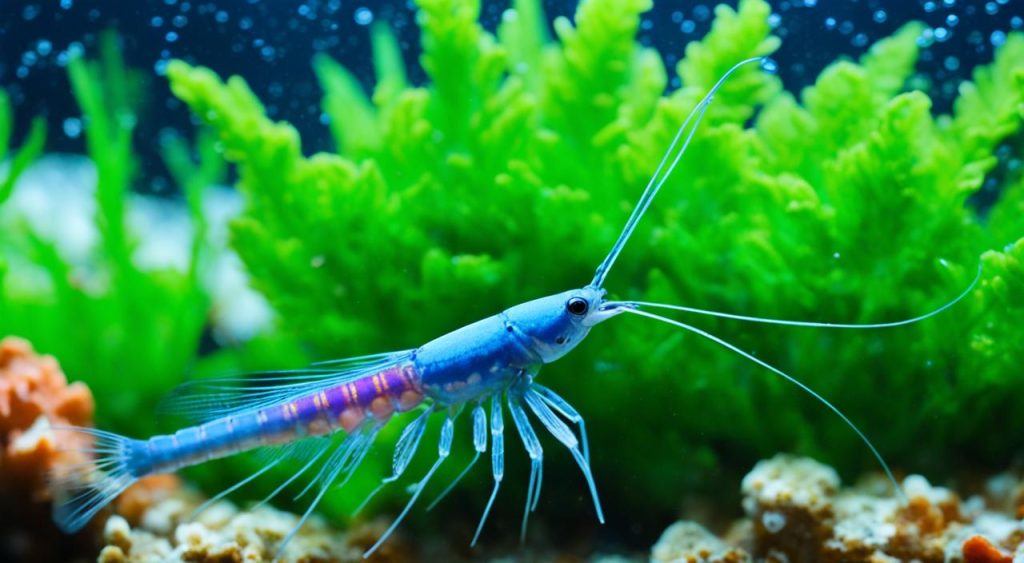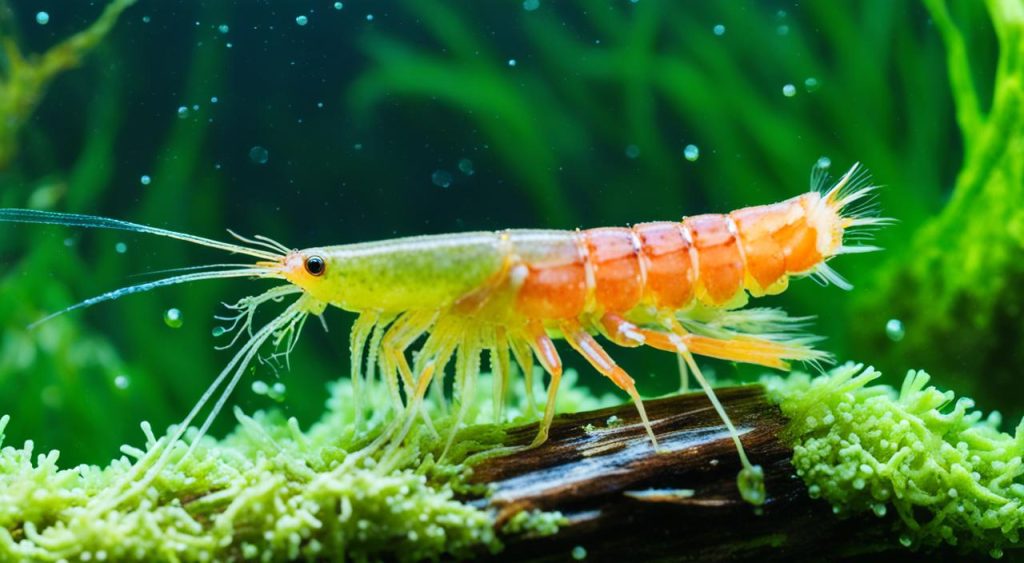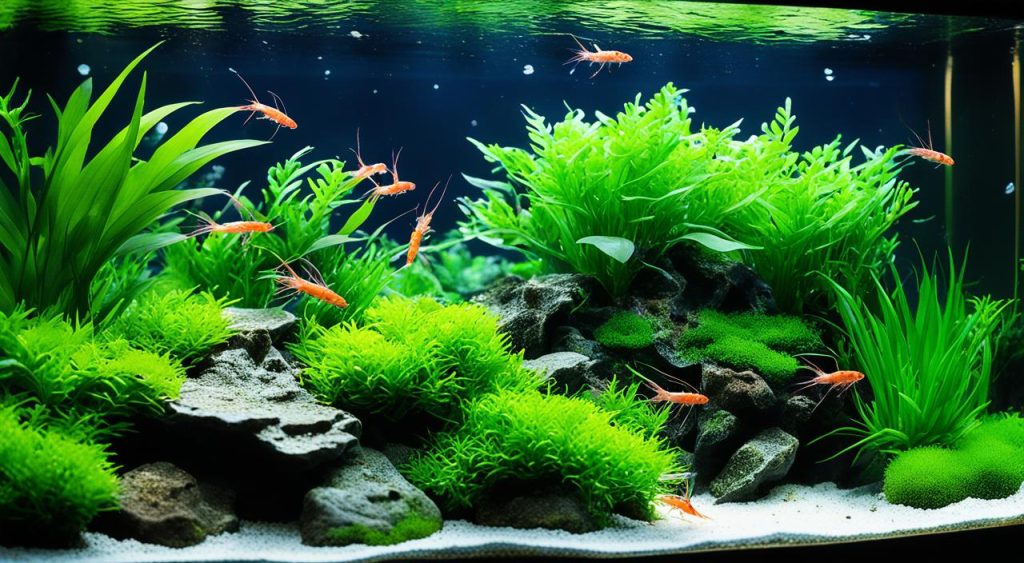Aquarium lovers, we have great news for you! If you’re fighting with algae in your tank, there’s a solution. It’s the Amano shrimp, also known as Caridina multidentata or Yamato shrimp. These small freshwater shrimp can grow up to 2 inches (5 cm) and are famous for eating algae.
Takashi Amano, the father of modern aquascaping, introduced these shrimp to the aquarium world. Now, they’re a top choice for those who want to control algae naturally and effectively. Amano shrimp can eat many types of algae, like hair algae, thread algae, and black beard algae. They’re the best way to keep your tank clean.
But that’s not all. Amano shrimp are also great because they don’t add much to the tank’s load and are very peaceful. They get along well with many small fish. Whether you have a small nano tank or a big aquarium, adding these shrimp is a smart move.
What are Amano Shrimp?
Amano shrimp, known scientifically as Caridina multidentata, are a type of dwarf shrimp from East Asia. They come from Japan, Taiwan, and Korea. These shrimp stand out with their clear bodies and a stripe running down their backs.
Origins and Physical Characteristics
Amano shrimp grow to be 1.5-2 inches long, a bit bigger than cherry shrimp. Males are smaller and have dots on their sides. Females are bigger and have dashes instead. Their transparent shells let you see their insides.
Interesting Behaviors and Non-Breeding Nature
Amano shrimp love to eat algae and other food bits. They also like to climb up on plant leaves. Unlike other shrimp, they can’t breed in regular tanks. Their babies need saltwater to survive.
| Characteristic | Description |
|---|---|
| Size | 1.5-2 inches (4-5 cm) |
| Color | Clear-colored with tan or gray-blue tint, solid stripe down back |
| Behavior | Constant grazing, climbing plants, non-breeding in freshwater |
| Habitat | Native to East Asia, particularly Japan, Taiwan, and Korea |
“Amano shrimp are extremely difficult to breed in freshwater aquariums and require brackish water for successful reproduction.”
Setting Up the Ideal Amano Shrimp Aquarium
Amano shrimp are tough and can live in many conditions. They like a temperature of 65–82°F (18–28°C), a pH of 6–8, and moderate to hard GH. They can fit in most nano tanks, but make sure it has a tight lid to keep them in.
Amano Shrimp Tank Setup
For the best amano shrimp tank setup, use a tank full of live plants and decorations. They like to eat and hide when they molt, so plants are key. Use sponge filters to keep the water clean without harming the shrimp.
Amano Shrimp Tankmates
For amano shrimp compatible tank mates, pick peaceful fish and invertebrates of similar size. Good choices include tetras, Endler’s livebearers, corydoras catfish, bristlenose plecos, kuhli loaches, other shrimp, and snails. But, stay away from big fish like medium to large cichlids, barbs, and goldfish.

By knowing the amano shrimp tank requirements and setting up well, you can have a happy Amano shrimp community. Enjoy their help in keeping your tank clean.
Amano Shrimp: The Ultimate Algae Eaters
Amano shrimp are known for their great ability to eat algae. They are perfect for keeping algae under control in aquariums. These shrimp eat many types of algae, including amano shrimp algae eaters, amano shrimp algae control, and black beard algae. They can reach into tight spots to clean up leftover food and algae.
They are very good at controlling algae. Their constant eating and hunger for algae make them a great choice for a healthy aquarium.
Amano shrimp grow to be 1.5–2 inches (4–5 cm) big, a bit larger than cherry shrimp. They live in freshwater and low brackish waters, coming from East Asia. Countries like Japan, Taiwan, and Korea are their home.
They like a wide range of water conditions. They need temperatures of 65–82°F (18–28°C), pH levels of 6 to 8, and moderate to hard GH.
Amano shrimp are good for small tanks with a secure lid because they have a low bioload. They can live with peaceful fish like tetras, Corydoras catfish, and snails. But, keep them away from big fish that might eat them.
| Amano Shrimp Comparison | Size | Algae Consumption | Breeding Difficulty |
|---|---|---|---|
| Amano Shrimp | 1.5-2 inches | Highly Effective | Extremely Difficult |
| Cherry Shrimp | 0.8-1.2 inches | Effective | Easy |
| Cardinal Shrimp | 1-1.5 inches | Effective | Challenging |
Amano shrimp have transparent shells, letting you see their insides. They are great at cleaning up hair algae, thread algae, and black beard algae. They are the second most popular dwarf shrimp in the hobby after Red Cherry Shrimp. They are easy to find and not too expensive.
In conclusion, Amano shrimp are the best choice for controlling algae in your aquarium. They eat many types of algae, are easy to care for, and get along with peaceful fish. They are a must-have for a balanced aquarium.
Feeding Your Amano Shrimp
Amano shrimp eat a mix of foods to stay healthy. They love to eat algae but will also take extra food. This helps them get all the nutrients they need.
Dietary Requirements and Supplementation
Here are some good foods for Amano shrimp:
- Shrimp-specific pellets
- Algae wafers
- Hikari Crab Cuisine
These foods give them the amano shrimp diet the calcium they need for molting and staying healthy. But, don’t overfeed them. This way, they’ll eat the amano shrimp food and amano shrimp nutrition from the algae in their tank.
Amano shrimp also like to eat:
- Blanched vegetables (like zucchini or spinach)
- Decaying plant matter
- Biofilm
- Leftover fish food

Introducing Amano Shrimp to Your Aquarium
Adding Amano shrimp to your aquarium is exciting and rewarding. But, it’s important to introduce them properly. This ensures a smooth transition and keeps stress low. When adding Amano shrimp, it’s key to take it slow. Let them adjust gradually to the new water conditions.
- Begin by floating the sealed bag with the Amano shrimp in your aquarium for at least 30 minutes. This lets the water temperature match and helps the shrimp get used to the new place.
- Then, add small amounts of tank water to the bag every 5-10 minutes. This helps the Amano shrimp get used to the changes in pH, temperature, and other water factors.
- Once the acclimation is done, carefully put the Amano shrimp into the aquarium. Make sure they have lots of hiding spots and a stable, mature environment to live in.
By taking the time to safely introduce Amano shrimp to your aquarium, they can adapt and settle in well. This helps them stay healthy and happy for a long time.
“Proper acclimation is the key to successfully adding Amano shrimp to your aquarium. Rushing the process can lead to stress and potential health issues for your new shrimp.”
Amano shrimp are sensitive to water quality and sudden changes. So, it’s crucial to watch their behavior and the water closely during and after the acclimation. With patience and care, you can safely introduce Amano shrimp and enjoy their benefits in your aquarium.
Amano Shrimp and Planted Tanks
Amano shrimp are great for any planted aquarium. They love to live in tanks with lots of plants. They help keep the tank clean by eating algae. Plus, they get along well with many plant species.
In a planted tank, Amano shrimp find lots of places to hide. This makes them feel safe and happy. They then work hard to keep the tank clean by eating algae and helping with aquascaping.
Amano shrimp are great at eating different types of algae. They eat hair algae, thread algae, and black beard algae. This stops these algae from taking over the tank, keeping it looking good and healthy.
| Amano Shrimp Characteristics | Value |
|---|---|
| Size | 1.5–2 inches |
| Origin | East Asia (Japan, Taiwan, Korea) |
| Water Parameters | 65–82°F, pH 6–8, moderate to hard GH |
| Tankmates | Peaceful community fish, snails |
| Diet | Algae, fish food, blanched vegetables |
Amano shrimp are amazing at eating algae and live well with many plants. They are a key part of making a planted tank look great and stay healthy.

“Amano shrimp are considered one of the best natural solutions for controlling algae in planted tanks.”
The Pros and Cons of Keeping Amano Shrimp
Amano shrimp are loved by many aquarium fans for their great algae-eating skills, calm nature, and simple care. They can live well in many water types, making them perfect for both new and seasoned aquarium owners. But, there are some downsides to consider when having Amano shrimp.
Benefits of Amano Shrimp
- They eat algae like hair, thread, and black beard algae.
- They can live in a variety of water conditions, including freshwater and low brackish water.
- They are peaceful and get along well with many other fish and shrimp.
- They are easy to care for and don’t need a big group to be happy.
- They can live up to 3 years, adding long-term value to your aquarium.
Drawbacks of Amano Shrimp
- They can’t breed in freshwater tanks and need new shrimp added.
- They might take over food and resources from smaller shrimp.
- They are good at jumping out of tanks, so they need a secure top.
- If there’s no algae, they might eat aquatic plants.
- They can be aggressive when eating, which might bother other tank mates.
The good things about Amano shrimp, like their great algae-eating and hardiness, usually outweigh the bad. With the right tank setup, tank friends, and feeding plan, Amano shrimp can be a great addition to your aquarium.
| Pros | Cons |
|---|---|
| Effective algae eaters | Unable to breed in freshwater |
| Adaptable to various water conditions | Outcompete smaller shrimp for food |
| Peaceful and non-aggressive | Skilled escape artists |
| Easy to care for with low bioload | May eat aquatic plants |
| Long lifespan up to 3 years | Exhibit aggressive feeding behavior |
“Amano shrimp are a must-have for any aquarium enthusiast looking to effectively manage algae growth.”
Amano Shrimp Care and Maintenance
Looking after your amano shrimp is key to their health and a balanced tank. It’s important to clean the tank and change the water regularly. These steps are vital for amano shrimp care and maintenance.
Tank Cleaning and Water Changes
To help your amano shrimp thrive, change 25% of the water every 1-2 weeks. This removes waste, uneaten food, and harmful substances like nitrates. Use a gravel vacuum to clean the substrate and get rid of debris during these changes.
Also, do deep cleans of the tank now and then. Clean the glass, trim plants, and remove algae or detritus. Amano shrimp eat algae, but they might need help with big algae problems. Keeping their home clean and well-oxygenated is crucial for them.
Keep an eye on the water’s pH, temperature, and oxygen levels. Adjust them if needed to keep your amano shrimp happy. When they molt, don’t remove their empty shells. They need them to get minerals and nutrients.
Stick to a good amano shrimp care and maintenance routine. This way, you’ll have a tank that’s full of life and looks great. It will show off the beauty and benefits of these amazing crustaceans.

“Amano shrimp are some of the most efficient algae eaters in the hobby, making them a must-have for any planted tank enthusiast.”
Difference Between Amano Shrimp and Other Dwarf Shrimp
Amano shrimp, known as Caridina multidentata, stand out among other dwarf shrimp in the aquarium world. They can grow up to 2.5 inches, much bigger than the 2-inch ghost shrimp. This size difference is a key way to tell them apart.
Amano shrimp don’t have the back hump that ghost shrimp do. Instead, they sport dots and dashes on their sides. These patterns make them visually striking. They are also known for eating algae better than other dwarf shrimp.
| Characteristic | Amano Shrimp | Ghost Shrimp |
|---|---|---|
| Maximum Size | 2.5 inches (6.35 cm) | 2 inches (5 cm) |
| Back Hump | Absent | Present |
| Color Pattern | Dots and dashes on translucent body | Red antenna bands and sprinkle of dots |
| Algae Eating Ability | Superior | Moderate |
| Behavior | Relaxed and less bold | More active and potentially feisty |
| Breeding | Require brackish/saltwater conditions | Easier to breed in freshwater |
Amano shrimp have a unique way of breeding. They need brackish or saltwater to breed, unlike other dwarf shrimp. This means they won’t mix with other shrimp in your tank. It’s a special trait that sets them apart.
Where to Buy Amano Shrimp?
Amano shrimp are famous for eating algae and are easy to find online and in local fish stores. They come from East Asia and are loved by aquarium fans all over the world.
When buying amano shrimp, choose trusted sellers who care about their shrimp’s health. You can get them in packs of 5 or 10. Prices range from $24.99 to $59.99, based on the pack size and seller.
It’s key to properly acclimate your amano shrimp when you bring them home. This helps them get used to your tank’s water and lowers stress. This makes them healthier and more lively in your aquarium.
| Online Retailers | Local Fish Stores |
|---|---|
| Aquarium Co-Op LiveAquaria Aquatic Arts | Your local fish shop Specialty aquarium stores Pet supply stores with aquarium sections |
Buying your amano shrimp from trusted sellers means they’ll be healthy and last longer in your tank. With the right care, they’ll do great and help keep your aquarium clean and colorful.
“Amano shrimp have been a game-changer in my planted tank. They keep the algae at bay and add a unique visual element to my aquarium.”
– Aquarium enthusiast, John Doe
Amano Shrimp in Community Tanks
Amano shrimp are great for community tanks because they are peaceful and don’t bother other fish or invertebrates. They eat algae, which keeps the tank clean and healthy.
These shrimp can live with small, calm fish like tetras, Endler’s livebearers, corydoras catfish, and kuhli loaches. They also get along with snails and other dwarf shrimp. But, it’s important not to put them with big, aggressive fish that might eat them.
| Tank Mates for Amano Shrimp | Incompatible Tank Mates |
|---|---|
| Tetras Endler’s Livebearers Corydoras Catfish Kuhli Loaches Snails Dwarf Shrimp | Larger, Aggressive Fish Clown Loaches |
Amano shrimp do well in a 75-gallon tank with many peaceful fish. You can have dwarf gouramis, neon tetras, corydoras catfish, clown loaches, rubberlip plecos, platies, khulis, otocinclus, siamese algae eaters, angelfish, and pear gouramis with them. But, don’t put clown loaches with them because they might eat the Amano shrimp.
“Amano shrimp are the ultimate algae-eaters, making them an invaluable addition to any community tank.”
Fascinating Facts About Amano Shrimp
Amano shrimp are truly unique creatures. They have a transparent look, almost invisible, and you can see their insides. They love to eat and climb up plant leaves. They even take food from other fish in the tank.
These shrimp can’t reproduce in regular aquariums. Their babies need saltwater to survive. This stops them from taking over the tank.
Amano shrimp come from East Asia, like Japan, Taiwan, and Korea. They are very popular in aquariums, after Red Cherry Shrimp. They can grow up to 2 inches long, making them bigger than some other shrimp.
They eat a lot of algae, but also like leftover fish food and veggies. They enjoy shrimp pellets, fish flakes, algae wafers, bloodworms, and blanched veggies like zucchini or spinach.
One cool thing about Amano shrimp is you can see their insides through their shells. They are also great at escaping, so their tanks need a tight lid to keep them in.
FAQ
What are Amano Shrimp?
Amano shrimp, also known as Caridina multidentata or Yamato shrimp, are freshwater dwarf shrimp from East Asia. They are famous for eating algae and are often kept in aquariums to control algae.
What are the unique characteristics of Amano Shrimp?
Amano shrimp have a clear body with a tan or gray-blue tint and a stripe down their back. Males are smaller with dots on their sides, while females are bigger with dashes. They like to graze, climb plants, and take food from bigger fish.
Can Amano Shrimp breed in freshwater aquariums?
No, Amano shrimp can’t breed in regular freshwater tanks. Their larvae need brackish or saltwater to survive. This makes them a non-breeding species for aquariums.
What are the ideal water parameters for Amano Shrimp?
Amano shrimp are adaptable and thrive in various water conditions. They like temperatures of 65–82°F (18–28°C), a pH of 6–8, and moderate to hard GH. They fit well in most nano tanks, but need a tight lid to stop them from jumping out.
What type of tankmates are suitable for Amano Shrimp?
Amano shrimp get along with peaceful fish and invertebrates like tetras, Endler’s livebearers, and bristlenose plecos. But, avoid fish that could eat them, such as large cichlids and goldfish.
How effective are Amano Shrimp at controlling algae?
Amano shrimp are great at eating algae, making them perfect for keeping algae under control in aquariums. They eat many types of algae, including hair, thread, and black beard algae.
What should I feed Amano Shrimp?
Amano shrimp eat a mix of foods like fish food, blanched veggies, biofilm, rotting leaves, and algae. You can give them shrimp pellets, algae wafers, and Hikari Crab Cuisine for molting.
How do I acclimate Amano Shrimp to a new aquarium?
To slowly introduce Amano shrimp to their new home, float the bag with them in the tank for 30 minutes. Then, add tank water to the bag a little at a time every 5-10 minutes.
How do Amano Shrimp benefit planted aquariums?
Amano shrimp are great for planted tanks because they love to live among plants and eat algae. This helps keep your planted tank clean and looking good.
What are the pros and cons of keeping Amano Shrimp?
Keeping Amano shrimp has many benefits like their algae-eating skills and peaceful nature. But, they can’t breed in freshwater tanks and might outcompete smaller shrimp for food. They’re also good at escaping, so your tank needs a tight lid.
How do I maintain Amano Shrimp in my aquarium?
Take care of Amano shrimp by keeping their tank clean and stable. Change about 25% of the water every 1-2 weeks and clean the tank well. Check and adjust the water as needed to keep it perfect for them.
How are Amano Shrimp different from other dwarf shrimp species?
Amano shrimp stand out because they’re bigger, up to 2 inches (5 cm), and have a clear look with a stripe. They can’t breed in regular aquariums, unlike other dwarf shrimp.
Where can I purchase Amano Shrimp?
You can buy Amano shrimp from online shops and local fish stores. They’re mainly caught in the wild in East Asia, so most are from these areas.
Can Amano Shrimp be kept in community tanks?
Yes, Amano shrimp are great for community tanks because they’re calm and get along with many fish and invertebrates. They help keep the tank clean by eating algae.




